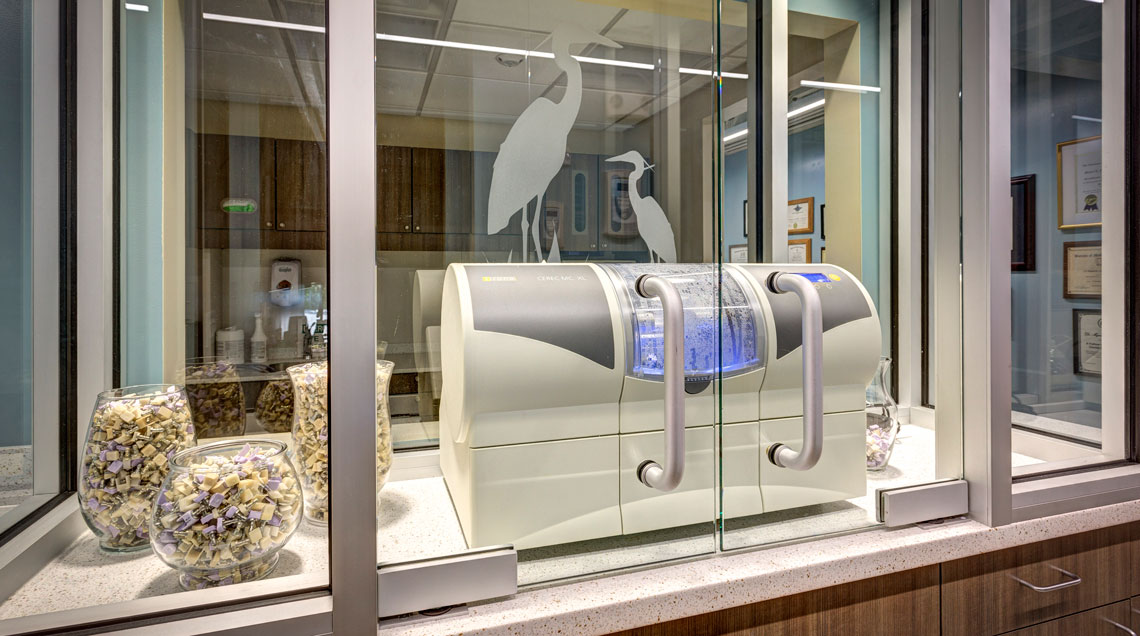What Are All-on-4® Dental Implants?

All-on-4® Dental Implants are an alternative to conventional dentures and serve as a permanent solution to missing teeth. Surgically placed into your jaw, they look, feel, and function like natural teeth. Also referred to as full arch dental implants and implant hybrid bridges, they are custom-created for your mouth and have many advantages over conventional dentures. Some of these advantages include:
- All-on-4® dental implants are a full set of implants designed to replace your entire upper or lower set of teeth. They act as a more permanent and natural-looking alternative to dentures.
- According to The American Academy of Periodontology, they are superior to traditional dentures when it comes to preserving bone structure and function. The full implants replace some of the tooth roots and integrate with the jawbone, which helps keep the jawbone intact. With traditional dentures, the bone that previously surrounded your tooth can weaken and deteriorate over time, resulting in a collapsed smile.
How Does CEREC® Technology Work?

CEREC® Technology, which stands for Chairside Economical Restoration of Esthetic Ceramic, is a state-of-the-art method of creating natural tooth restorations. We’ve been using CEREC® technology since 2006 to make crowns, bridges, inlays, onlays, and veneers out of ceramic material to restore the natural beauty and function of your teeth.
What does CEREC Technology mean for you?
One of the biggest advantages of CEREC® is its convenience. Typically, we can make crowns or bridges in our office on the same day as your visit. Using CEREC® technology is also more comfortable for many patients as it eliminates the need for biting on the traditional impression trays which can be messy and cause many people to gag. Plus, no more plastic temporary crowns that fall off!
What Should I Do if I Lose a Filling?
 Dental fillings are an incredibly common type of dental restoration used to treat cavities and decay. And while fillings are strong and built to last for many years, sometimes things happen and they fall out. Here are a few tips on what to do if this happens to you.
Dental fillings are an incredibly common type of dental restoration used to treat cavities and decay. And while fillings are strong and built to last for many years, sometimes things happen and they fall out. Here are a few tips on what to do if this happens to you.
Find the filling and keep it clean and safe
When your filling falls out, rinse it off with water and keep it in a resealable plastic bag. Bring it to your dentist’s office because it may be reusable if it’s not broken.
Carefully clean around the affected tooth
Gently rinse your mouth and brush the affected tooth to remove any food debris that may have become lodged in the exposed area. Stop brushing if you feel any pain, as this could be due to an exposed nerve.
Call your dentist
After you’ve cleaned your mouth, call your dentist to see if you can make an appointment for that day or the next day. At the appointment, your dental team will assess the affected area and look for any damage. Sometimes your dentist may recommend replacing the filling with another filling or, depending on what happened, they may suggest a dental crown. Dental crowns cap the entire tooth and provide even more protection than a filling.
What Causes Tooth Loss in Adults?
 As a kid, a loose tooth meant a fun visit from the Tooth Fairy. But losing teeth as an adult isn’t nearly as exciting. Adults only have about 25 permanent teeth, making tooth loss a potentially serious ordeal. Here are a few major causes of tooth loss adults and tips on how to improve your oral health:
As a kid, a loose tooth meant a fun visit from the Tooth Fairy. But losing teeth as an adult isn’t nearly as exciting. Adults only have about 25 permanent teeth, making tooth loss a potentially serious ordeal. Here are a few major causes of tooth loss adults and tips on how to improve your oral health:
Your Daily oral Care Regimen May be Lacking
Your dentist is your first line of defense against tooth loss, so make sure to keep your regular cleanings and check-ups. Your dentist will check your teeth for any problems — like cavities, oral cancer, and other diseases — and address any issue before it’s too late.
Brushing your teeth twice a day, flossing, and using an anti-plaque mouthwash can also help keep your teeth healthy and strong, as it eliminates harmful bacteria from lingering and weakening your enamel.
Teeth Grinding
Grinding your teeth at night can cause breakage, sensitivity and possibly even tooth loss. If you think you grind, gnash or clench your teeth at night, talk to your dentist about getting a mouthguard to wear while you sleep.
Why We Use the Latest in Digital Dentistry
 Like nearly every other industry, dentistry has dramatically changed (and benefited from) the increased use of technology. Digital dentistry, or the use of any dental technology or device that uses digital or computer-based components, has improved patient care in many ways. Not only have many new treatments been invented, but older treatments have also been streamlined or made safer, improving patient outcomes overall.
Like nearly every other industry, dentistry has dramatically changed (and benefited from) the increased use of technology. Digital dentistry, or the use of any dental technology or device that uses digital or computer-based components, has improved patient care in many ways. Not only have many new treatments been invented, but older treatments have also been streamlined or made safer, improving patient outcomes overall.
Understanding and keeping up with the innovative changes happening in dentistry can feel overwhelming. But being in the know can help keep patients feel informed about their diagnosis, treatment options, and overall oral health. Here are a few ways we use digital dentistry to improve your care:
Digital X-rays: Digital X-rays are a great improvement in dental radiography because they reduce exposure to radiation and are more comfortable for you. Capturing the images on a computer, digital X-ray images can also be magnified, which allows for improved diagnostic accuracy.
How SureSmile® Can Improve Your Smile
 Orthodontic treatment with SureSmile® Aligners can improve your smile faster and easier than you ever thought possible. SureSmile® is a technology-based straightening system that combines aspects of traditional braces with modern technology to create a series of clear, custom-fit molds for your best smile ever.
Orthodontic treatment with SureSmile® Aligners can improve your smile faster and easier than you ever thought possible. SureSmile® is a technology-based straightening system that combines aspects of traditional braces with modern technology to create a series of clear, custom-fit molds for your best smile ever.
Here’s how SureSmile® improves your smile:
It’s completely customized
The SureSmile® Aligners system uses 3-D technology to move your teeth more efficiently and directly into their proper position. Using custom-printed models and robotic laser trimming, your aligners will have an incredible fit and precise function for your personal needs.
Incredible precision and modern design
SureSmile® Aligners are created using a modern algorithm, a robust Cloud-based software platform, and an expert digital lab team to straighten your smile tooth-by-tooth. This precision not only results in total comfort, but also gives your dentist the power, control, and flexibility to ensure your treatment creates your dream smile.
Top-rated materials
SureSmile® Aligners are made with world-renowned Essix® plastic, which is known for its superior performance at straightening teeth and its virtually invisible aesthetic, making your treatment that much better for everyday life. And thanks to its effective design, these aligners produce amazing results in 30% less time than traditional braces do.
Schedule an Appointment Today
If you’re interested in learning more about how SureSmile® Aligners can create your perfect smile, make an appointment with us today!
What are fillings?
 A dental filling is an extremely common dental procedure used to help to protect your teeth from further decay. Whether you have a cavity, enamel loss, or tooth breakage, fillings are artificial materials used to reinforce your teeth and keep them healthy. If you need a filling, your dentist will consider a number of factors when choosing which type is best for you. These factors may include cosmetic considerations (like where in your mouth the filling needs to go), the cost, and the extent of the needed repair.
A dental filling is an extremely common dental procedure used to help to protect your teeth from further decay. Whether you have a cavity, enamel loss, or tooth breakage, fillings are artificial materials used to reinforce your teeth and keep them healthy. If you need a filling, your dentist will consider a number of factors when choosing which type is best for you. These factors may include cosmetic considerations (like where in your mouth the filling needs to go), the cost, and the extent of the needed repair.
There are several types of fillings available, including:
- Composite Fillings – A composite resin filling is made from a mixture of fine plastic and glass particles. It is made to match the natural color of your tooth and is most often used on the front teeth or wherever it might be visible. This type of filling bonds directly to the tooth, which makes it very strong and durable.
- Amalgam Fillings – Amalgam fillings are made from a mixture of metals including mercury and silver. These fillings don’t match your teeth and so are most commonly used for problems with your back molars. These filings are very strong and can last for ten years or longer.
- Ceramic Fillings – Ceramic fillings are made of tooth-colored porcelain that has a very natural look. While they are resistant to staining, they can be more fragile than amalgam fillings and are a much more expensive option.
Should Adults Continue Fluoride Treatment?
 You probably remember getting fluoride treatments as a kid. Or maybe you’re familiar with the fluoride rinses your children get. But are fluoride treatments suitable for adults? While not always necessary for adults, it’s actually a common misconception that fluoride only works for developing teeth in kids and professional opinion is generally in favor of adult fluoride treatment for many reasons. If you’re on the fence, here are some reasons it may be beneficial for you.
You probably remember getting fluoride treatments as a kid. Or maybe you’re familiar with the fluoride rinses your children get. But are fluoride treatments suitable for adults? While not always necessary for adults, it’s actually a common misconception that fluoride only works for developing teeth in kids and professional opinion is generally in favor of adult fluoride treatment for many reasons. If you’re on the fence, here are some reasons it may be beneficial for you.
- If you’re experiencing receding gums, fluoride treatments can slow down that process and protect your enamel from softening.
- If you have crowns or bridges in your mouth, fluoride can protect restorative dental work that could be in jeopardy because of weakening teeth.
- If you have sensitive teeth, fluoride can help. Many adults consume foods that are acidic or use at-home teeth-whitening products which can lead to increased sensitivity or sore gums. Fluoride can help reduce sensitivity by strengthening your enamel.
How Dental Hygiene Affects Your Overall Health
 Good oral health is about so much more than just your teeth and gums. Your mouth is the entryway to your body and without proper oral hygiene, bacteria can grow and spread and cause issues throughout your entire body. Here are some surprising health problems caused by poor oral health.
Good oral health is about so much more than just your teeth and gums. Your mouth is the entryway to your body and without proper oral hygiene, bacteria can grow and spread and cause issues throughout your entire body. Here are some surprising health problems caused by poor oral health.
Gum Disease
Also referred to as periodontal disease, gum disease is an infection that affects the gum tissues and bones surrounding your teeth. Typically the result of poor brushing and flossing habits, periodontal disease occurs after bacteria from untreated plaque have caused an infection. Because our body’s response to infection is inflammation, gum disease can put our body under a lot of stress from chronic inflammation.
Cardiovascular Disease
If the gums are inflamed due to the bacteria that cause periodontal disease, that same bacteria can actually get into your bloodstream. This bacteria can form plaque on your arteries that can harden and result in atherosclerosis, a very serious condition that can increase your risk of heart attack and stroke. The bacteria can also cause endocarditis, a serious condition that occurs when the lining of the heart becomes infected.
Dental Tips for Fall
 As the seasons change, it can be a great time to refresh your health, too. The coming of fall can be the perfect time to get into better habits for your oral hygiene. Here are a few tips to have your healthiest smile ever this season:
As the seasons change, it can be a great time to refresh your health, too. The coming of fall can be the perfect time to get into better habits for your oral hygiene. Here are a few tips to have your healthiest smile ever this season:
- Replace your toothbrush: A lot of people use the changing of the seasons to do some housekeeping, like replacing heating unit filters, blankets, and gutters. But why stop at home maintenance? It’s also a great time to switch out your toothbrush! As a general rule of thumb, toothbrushes should be replaced every three to four months.
- Eliminate a habit: A new season is a great time to reflect on your bad habits and make better choices. Whether it’s smoking, drinking too much soda, or eating too much candy, try using the new season to eliminate a habit that harms your teeth.
- Start a new healthy habit: After you eliminate one bad habit, try replacing it with one good habit! This fall, try something you may not be familiar with to give your mouth a boost. Ideas include trying a charcoal-based toothbrush, wearing a mouthguard at night if you think you might grind your teeth, or dry brushing your teeth.
Top 3 Benefits of Whitening Your Teeth

Everyone wants a bright, white smile, right? But most people also want coffee, tea, wine, and soda—all things that stain our teeth and make the dream of a healthy white smile seem out of reach. But achieving a pearly white smile is actually easier than most people think! Teeth whitening procedures are a simple way to make a big difference. Here are the top 3 benefits of opting for a whitening treatment.
Self-Esteem Boost
The most obvious benefit of teeth whitening is the impact it will have on your self-esteem! Feeling good about yourself is important and with a bright, white smile you won’t have to think twice about smiling big and showing your teeth. You’ll notice more confidence at work, speaking in front of a crowd, on a date, or even just walking down the street. In addition to boosting your confidence, a white smile is also known to offset the effects of aging. Win, win!

